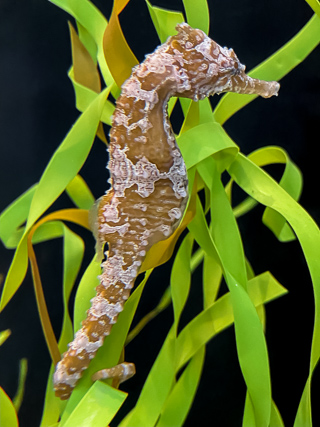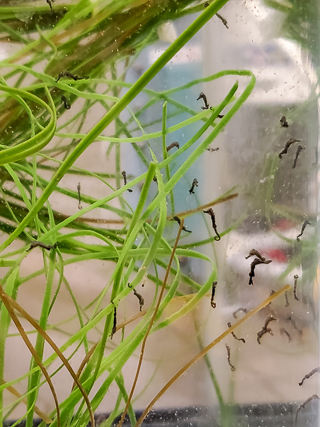At the Museum: Seahorse breeding
For immediate release ‐ February 10, 2022
Contact: Micah Beasley, 919.707.9970. Images available upon request
By Leanne Pietraniec, Curator of Fish and Invertebrates and Elizabeth Reese, Assistant Curator of Fish and Invertebrates
With Valentine’s Day just around the corner, love will soon be in the air at the Museum, at least in the seahorse tank. Here at the Museum, we have Lined Seahorses (Hippocampus erectus) on display in the Eelgrass exhibit on the first floor of the Nature Exploration Center. Currently, there are only female seahorses on display, but we are making plans to re-introduce the males to see if we can encourage breeding. Lined Seahorses have previously bred in the backup seahorse system. We are excited and hopeful that once introduced, they will successfully breed again!
Lined Seahorses are monogamists, meaning they stick with one partner for their entire life. Once they’ve found their partner, they will perform ritualistic courtship dances together every day. These ritualistic dances include moving through a rhythmic sequence of twirls and entwining their tails together. The dances can last for several minutes or even hours. They perform these dances with one another to strengthen their romantic bonds and to solidify their commitment as mates.
Like all members of the Syngnathidae family, Lined Seahorse males have a brood pouch that is used to carry the eggs during development. After a successful courtship dance, the female will transfer her eggs into the male’s pouch, where they are fertilized by the male. The eggs will take about 20-21 days to gestate (develop) in the brood pouch. After gestation is complete, the male will give birth to the baby seahorses, which are called fry.
The fry look like miniature versions of the adult seahorses and have functioning prehensile tails just like the adults. Seahorses are poor swimmers, so this tail allows them to hold onto things like seaweed and prevents them being swept away in the strong ocean currents. Since the seahorse fry are even smaller and weaker than the adults, they are more prone to being carried away in the currents. Therefore, it is especially important that the fry can use their tails from the moment they are born.
Seahorses do not have a stomach and digest food very quickly. They also use a lot of energy to move around, so they need to eat almost constantly. This is especially true for seahorse fry. At the Museum, their tanks are flooded with tiny invertebrates known as rotifers to feed on. After a few weeks, the fry will be transitioned into eating another, slightly bigger invertebrate, which are one- to two-day-old brine shrimp (AKA sea monkeys). Finally, at six weeks old, the fry will make the final leap into eating frozen foods and live brine shrimp adults, which they will continue to eat throughout their lives. It takes about nine months for lined seahorses to reach maturity, at which point they will attempt to find their own life partner and continue the cycle.
For more information about our upcoming activities, conservation news and ground-breaking research, follow @NaturalSciences on Instagram, Twitter and Facebook. Join the conversation with #visitNCMNS.



